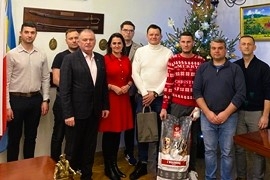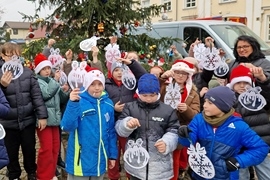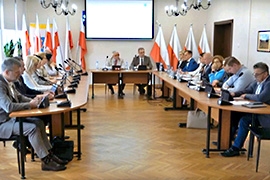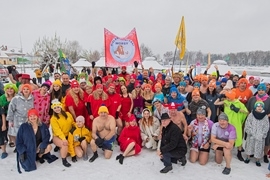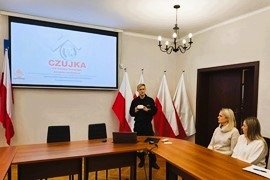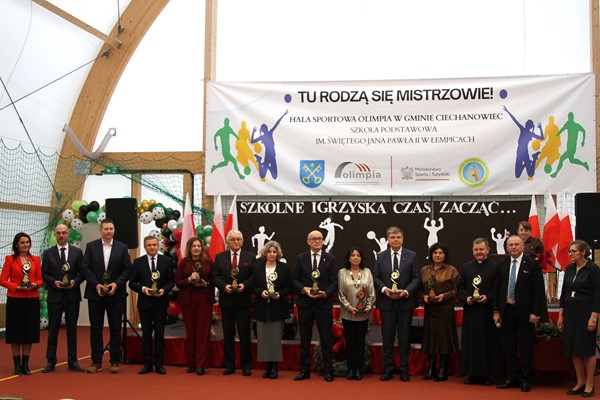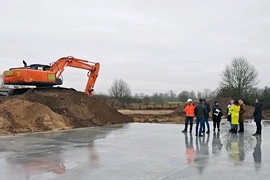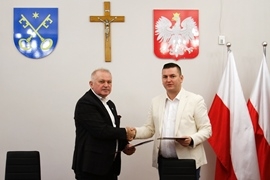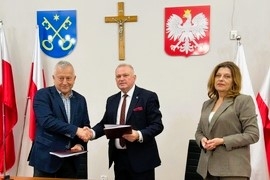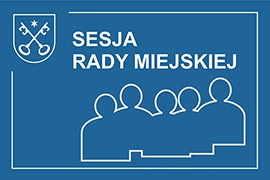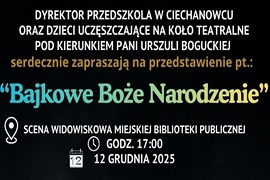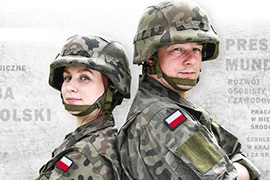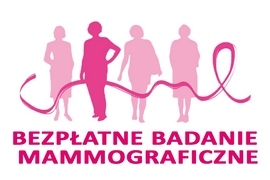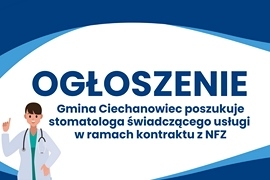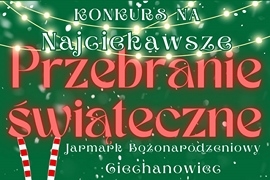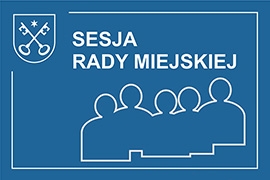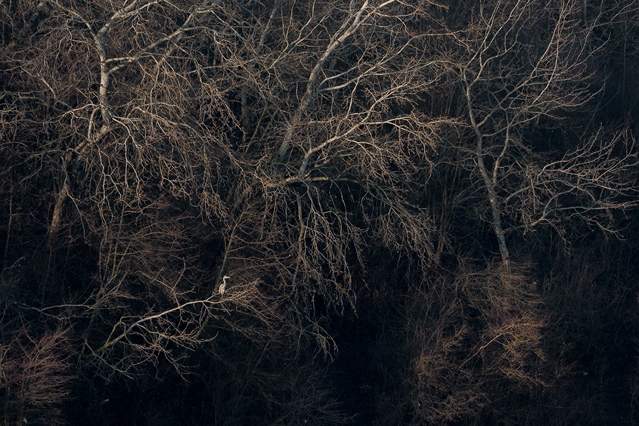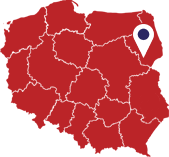- Szczegóły
- Kategoria: English
The St. Wojciech’s Fair
The tradition of Fairs for the St. Wojciech’s Day in Ciechanowiec has a long history. In the XIX century Ciechanowiec was the only town in the Grodno Gubernia where a many days long open-air market was held. With reference to these traditions in the beginning of the 90’s the Rev. Krzysztof Kluk Museum of Agriculture had made attempts to reactivate the Fair. St. Wojciech is the patron of the 23rd of April, and on the Saturday closest to that day the Museum organizes the open-air market, which opens the touristic season. Folk artists, merchants, craftsmen and gardeners are invited to the Museum of Agriculture. Throughout the day the exhibitors are accompanied by performances of folk bands and musicians.
Wysokomazowiecki Inn. The gentry’s history live
Since 2005 the County of a Starost in Wysokie Mazowieckie, the Narwian National Park and the Rev. Krzysztof Kluk Museum of Agriculture had been organizing a two day long cultural event, during which the tradition and history of backwater - the impoverished polish gentry - are presented. At first the event was taking place in Kurowo, where the Narwian National Park’s seat is located, and in the Museum of Agriculture in Ciechanowiec. Since 2007 the event has moved entirely to Ciechanowiec. The event’s programme is very rich: the participants of the events are able to familiarize with the XVII cent. gentry fashion, wedding customs, court dancing, the ways of setting up a confederation and electing it’s marshal. The other attractions are: the Swedish and Moscow forces parade, as well as a swordsmanship, horse riding, artillery sergeants and jugglers demonstrations. Contests for the audience are also held during the event. Everyone can taste regional dishes, see and buy local products, as well as purchase antiques.
Ciechanowiec days fete
Ciechanowiec days fete is one of the oldest events organized in Ciechanowiec - for the first time it took place in 1976. Traditionally it is organized in the Town Stadium by the Nurzec reservoir on Saturday closest to the Midsummer Eve’s night. On that day "Championships of Sołectw" (the lowest unit of local administration, usually comprising a single villages) are riveting the attention of spectators. The Fete’s main act is the Contest for the prettiest flower wreath, lasting from the beginning of the event till the evening. After settling the contest and awarding prizes. The girls holding flower wreath and torch they are sitting down in kayaks and they are swimming for the middle of the reservoir. Then they put wreaths on the water. Throughout the fete the spectators can visit deli stands and listen to and watch the performances of music bands. The event ends with dancing and fireworks display.
Podlaskie Horse and cart driving competition
In 2005 Horse Riding Sports Club "Gepard" along with the Municipal Cultural Centre for the first time had organised the Podlaskie Horse and Cart Riding Competition. The prize was the Ciechanowiec Mayor’s Cup. This event starts with a Holy Mass, after which the procession of horses and carts is headed towards the Club’s grounds - where the competition is taking place. There are two competition categories: pairs and singles. After the competition the Lithuanian Lancers of Grabow 10th Regiment Sports-Horse Riding Association presents the art of sabre and lance wielding. During the whole event spectators may watch the gentry dress replicas presented by the Marksmen’s Society, listen to cheers and canon salvos. The programme includes performances of folk and light bands, dances and a fireworks display.
Podlaskie Bread Festival
For the first time Podlaskie Bread Festival had taken place in 2001. This festival consists of several events taking place in Ciechanowiec and the Museum’s premises: The Polish Bakers’ Cork Fishing Championships, procession from the church to the Museum, consecrating the farm animals, the harvest festival ceremony (old customs are being presented - reaping crops with a sickle and a scythe, ploughing the quail - that is dragging a young harvester through a stubble round four handfuls of not harvested crop left there). After midday the results of the contests lasting since morning are being decided: the Contest for the best baking stand and the Contest for making a „równianka”, that is a kind of a bouquet, which is consecrated in the church for Mother of God Herbaceous. Throughout the day in the Museum’s premises baking, craft and merchant stands are open for customers. It is also possible to listen to performances of folk and various other bands.
Contest of playing on folk pastoral instruments "Ligawki"
Ligawka is a traditional folk instrument, sometimes described as a natural wooden trumpet. The first Ligawki Playing Contest had taken place in Ciechanowiec in 1974. In 1980 it was transformed into the All-Poland Instruments Playing Contest. Every year over 100 contestants from all over Poland participates in the Competition. The age span of the contest’s participants varies from 3 to 86 yrs. Since a couple of years Lithuanians, Germans, Irishmen, Ukrainians, Spaniards and Australians had also been taking part in the contest. In 2006, to commemorate the originator of the competition, the long standing director and the cofounder of the Museum of Agriculture, it was named after Kazimierz Uszyński. The Competition takes place always on the first Saturday and Sunday of the Advent, in several age categories - children and adults, and musical categories - ligawka playing competition, trombit playing competition, other herding instruments playing competition.
- Szczegóły
- Kategoria: English
The Rev Krzysztof Kluk Museum of Agriculture was built because of the Ciechanowiec Admirers’ Society’s initiative. On the fifth of July 1964 there was an official opening of the Social Museum of Agriculture. It was nationalized in 1968. At the beginning the Museum was situated in an old fire station, and in December 1969 it was transferred to a reconstructed Starzeńscy counts’ mansion in Ciechanowiec - Nowodwory.
Already in 1967, on the mansion’s grounds, had begun the building of an open-air museum – the first object was moved in July – a many-sided wooden manage (riding area) from the town of Usza Mała. At present the open-air museum consists of 44 historic objects (XVIII cent. - XX cent.).
Currently the Museum of Agriculture occupies a 26 ha area, owns two branches: in Drewnow (windmill with a miller’s homestead) and Dąbrowa Łazy (windmill), and eight departments:
- Ethnographic - the oldest department of the Museum, in possession of over 10000 exhibits
- Historically-Artistic - in possession of over 4000 historical exhibits and over 1000 artistic exhibits
- Department of Rural Architecture - Mazowiecko-Podlaski Open-air Museum, based on a project by Prof. Dr hab. Ignacy Felicjan Tłoczek, an outstanding expert on Polish rural architecture
- Department of Agricultural Technology - possesses the collection of over 700 machines, tools and documents concerning agricultural technology
- Department of the History of Cultivation - which collects, draws up and spreads the knowledge about history of cultivation in Poland
- Department of Raising and Breeding of Farm Animals - which collects, draws up, stores and spreads everything, which portrays the history of development of raising and breeding of animals. In the extent of the department in the open-air museum the native animal breeds are being bred
- Department of Herbal Traditions - regular tasks of the herbal department includes looking after the „Plants Fit for Medical Use Garden” based on the „Plant Lexicon” by Rev Krzysztof Kluk
- Museum of Veterinary - it was opened in 1982 and even though formally it remains a department of the Museum of Agriculture, on account of uniqueness of the subject, completeness of the collection and the importance for the national veterinarian circle it has been promoted to a rank of museum
- Szczegóły
- Kategoria: English
The Holy Trinity Church
The current parochial church was built from 1736 to 1739 by the architect Jan Kluk by the foundation of Franciszek Ossoliński. The church represents typical baroque style and there are sculptures inside that come from late baroque. Visiting the church it is worth to see the tomb epitaph with the marble bust of Rev. Krzysztof Kluk, which was made by the well known sculptor of the Polish classicism Jakub Tatarkiewicz. In the presbytery there are two memorials: one of Katarzyna from Ossoliński Jabłonowska and the other one the tomb memorial of Justyn Ciecierski. Out of paintings inside the church the most important are: the XVIII century Italian copy of the painting by Carl Maratti in the main altar, the painting of the cupper covered Madonna and the painting of St. Nicolas.
The monastery-hospital complex
The complex of the monastery of the Daughters of Charity of St. Vincent de Paul and the hospital was founded by the Ossoliński family.The hospital burnt several times. After the fire of 1915 it was rebuilt to house the city hall (1925). Next devastation of 1944 and reconstruction of 1954-1960, again to be a hospital with addition of the third level, completely changed the architecture of the building. Of the old complex only the gate with the dates of 1737-1925, the fragments of the old monastery walls and well preserved stone fence surrounding the old property of the Szarytki sisters are still in place.
The memorial of Rev. Krzysztof Kluk
In 1850 at the prominent city square there was an opening ceremony of the memorial of Rev. Krzysztof Kluk, which was founded by the owner of Ciechanowiec count Stefan Ciecierski. It was made by the great sculptor of the Polish classicism Jakub Tatarkiewicz. During the World War II, to preserve the monument, it was moved inside the church yard. Founded by Stefan Ciecierski they made also the statue of St. Florian, the saint patron of firefighters. The sculpture was made of sandstone in the Gothic Revival style.
The Lord’s Ascension Orthodox Church
The orthodox church was built in 1884 in the place of a taken down Unite church. Neither the interior nor the documents indispensable for reconstruction had been preserved. During the World War II civilians were being executed inside the church. An obelisk in honor of these casualties had been built on a square near the church.
The Market Square
There were two market squares with their corners joint together on the left-bank part of Ciechanowiec. The elegant marketplace was reconstructed in the XVIII century. A church complex was built on the east side and a monastery complex on the north side. The south side was occupied by the presbytery buildings. The rectangular-shaped commercial marketplace is much bigger, but only two of the old buildings have survived to this day: a XIX century one-storey house and a multi-storey building from the beginning of the XX century. The right-bank Ciechanowiec had had it’s own main triangle-shaped marketplace, but at present it is turned into a green. A couple of old one-storey houses have been preserved: stone and wooden houses on the Łomżyńska street and a XIX century stone multi-storey building in the market square’s corner.
The Mansion-Park Complex (the Museum of Agriculture)
The mansion complex and the remains of the park, preserved to this day with only a few changes, were built in the middle of the XIX century. The asymmetrical shape, neo-classical architectural details, rich molding and window frames and the columned porch have been designed by an architect Julian Ankiewicz. Treating the architectural details of stone buildings of the old stables, coach house and the wooden watermill separately proves the artist’s connection with the Bavarian architecture of this period. The outhouse and the Romantic, pseudo-fortified garden walls with a corner tower are of a slightly different character. Probably for both the purposes of the manor’s economy and for diversifying the park’s appearance, a wooden watermill had been placed by the outlet of the park’s pond. The manor service’ buildings, near the Pałacowa street, have been kept in close connection with the manor’s buildings. A forester’s lodge was situated just behind the entrance gate, and the three buildings used by the manor’s service had stood on the junction, just a little further. One of these buildings had preserved its original architectural form.
Mazowiecko-Podlaski Open-Air Museum
The museum’s exhibition, found in 1970, consists of old, wooden country buildings, brought here from Mazowsze’s and Podlasie’s borderland. These buildings are an illustration to different styles of architecture and building technique. The complex have been divided into three plain’ air exhibitions.
Part "A" – north-east. It has taken the place of a manor’s former orchard, from which three trees, planted in 1915, have remained. Historic wooden country buildings have been placed here in a form of backwater – a simplified exhibition of a countryside society’s cross section from the turn of the XX century. A pasture with a well and a sweep in the middle, as well as some willows, is in the centre of the complex.
Part "B" – south-west, situated in a former vegetable garden. In this part two homesteads and a collection of granaries and barns is presented.
Part "C" – situated on a plot with remains of the park’s old tree stand, on the other side of Pałacowa street.
Inside the museum’s buildings are presented ethnographic collections illustrating the peasant’s and every-day life and the old country craft. Local breeds of sheep and chicken are also raised here.
Monuments in Pobikry. The Bishop and Martyr St. Stanisław Church
The present church was built in 1857-60. It was founded by Stefan Ciecierski and designed by an Warsaw architect Ernest Bauman. Gothic Revival church, oriented and unplastered.
There are two historic, unplastered brick gates in the church cemetery’s fence:
- on the west side – the gate in a shape of a triple sharply-arched arcade
- on the north side – this gate has been built on a base of a square. Formerly a mortuary, currently a passageway to an adjacent cemetery
Historic tombs from c 1900 and 1881, with a cast-iron fence and cross, are located on a the cemetery.
Manor’s Outhouse
Manor’s outhouse is from the first half of the XIX century. Originally it had probably been built as a manor of the Ciecierscy family, and only later it had picked up the role of an outhouse. The outhouse is built on the base of a rectangle, in a neo-classical style. It is a wooden, plastered, one-storey, nine-axis building of a framework construction. The remains of a ruined park, of an alley leading to the town and a roadside cross from 1861 can be found on the south-east.
Monuments in Winna-Poświętna. Maiden and Martyr St. Dorothy’s Church
The church was built in 1696 by Andrzej Jabłonowski Grzymała and his wife Urszula of the Skiwscy family. The church is of a framework construction, wooden, with a stone underpinning and boarded. The church’s presbytery is turned to east (to Jerusalem) and the altar is baroque in style.
Next to the church there is a two-storey wooden church belfry with stone foundation and baroque bells:
- of 1652 with the signature of Augustyn Koesche, the craftsman of Toruń
- of 1757 with the signature of Rev. Idzi Dąbrowski.
Church graveyard: - classicistic gravestones from the first half of the 19th century. In the wall there are epitaphic boards from the second quarter of the 19th century: Graveyard - among others there are sandstone boards with inscriptions with the coat of arms of the Jelita Tchórznickich: Wiktor and Mateusz, sons of Wojciech, the co-owner of Winna in 1794.
- Szczegóły
- Kategoria: English
Ciechanowiec, back then just a fortified town, for the first time had been mentioned in the XIII century. The town was granted city rights by a Mazovian prince Janusz I the Great, probably at the beginning of the XV century. In 1434 the source mentions the Ciechanowian burgher for the first time, and since 1446 Ciechanowiec has its own Roman Catholic parish.
Since its founding till the beginning of the XX century Ciechanowiec had belonged to many families: Kiszkowie, Ciechanowieccy, Bremerowie, Jabłonowscy, Ossolińscy, Szczukowie, Ciecierscy and Starzeńscy. On account of its location Ciechanowiec was an important trade, road and defence centre. At the turn of the XV century one of the most important tracks from Mazowsze to Lithuania was leading through Ciechanowiec.
Ciechanowiec had been destroyed many times during: the Swedish Deluge (the Swedish invasion of Poland in 1655 – 1660), the II north war (1700 – 1721), the Polish-Russian war of 1792 and the Kościuszko’s Insurrection. After the third partition of Poland Ciechanowiec had been incorporated into the annexed territory under Prussian rule (1796 – 1806), and after the Napoleonic era Ciechanowiec had been permanently split into the left-bank Old Town and the right-bank New Town.
The development of Ciechanowiec had been quite successful during the Partitions period. Just before the outbreak of the World War I Ciechanowiec was inhabited by circa 15.000 residents. There were nearly 100 factories and around 300 trading points. During the World War I and the Polish-Soviet War of 1920, close to 65% of the city had been destroyed and the city’s population had dropped below 5000. Slow reconstruction of the war-damaged city got interrupted by an outbreak of the World War II. The double occupation of the city: Soviet in 1939 – 1941 and German in 1941 – 1944 resulted in further damage to Ciechanowiec. Nearly 85% of the city infrastructure was burned down and the population dropped to less than 2000 people.
After the liberation the first Municipal National Council had constituted itself on October 1944. The founding of the Trading – Grocery Partnership „Jedność” and the Municipal Co-educational Gymnasium were the most important actions of the Ciechanowiec’s people, taken even before the end of 1944. Among the buildings constructed in the following years are: an airfield (1951), the Municipal Hospital reconstructed in 1956, the pharmacy and the bakery (1963), the Firefighter’s House, the Book Store, the State Machines Centre (1966). Constructions of a dam on the Nurzec and a tourist centre Nurzec had also begun.
Above actions have not been left unnoticed. In 1966 Ciechanowiec was awarded with a nr 1 prize among the cities of Białostocczyzna with less than 5000 citizens. In 1971 it won the title of the Master of Thrift in its group, and in 1974 the title of the Grandmaster of Thrift. In 1975 the city have been awarded with the Commodore's Cross of the Order of Polonia Restituta.
As for the field of culture, an important fact is the forming of the Ciechanowiec Admirers’ Society in 1962, which led to founding of the main tourist attraction - the Rev. Krzysztof Kluk Museum of Agriculture in 1963.
- Szczegóły
- Kategoria: English
The commune of Ciechanowiec (county Wysokie Mazowieckie; province Podlaskie) occupies the area of 201 km 2 and has 9570 inhabitants. It is located in the Mazowiecko-Podlaski Lowland being the eastern part of the Great Valleys Region bordering Siedlce Heights to the south and Bielsk Heights to the East which is the water divide between the Narew and the Bug rivers.
The commune is agricultural with all necessary conditions for development of tourism and agriculturism. The country areas of Wojtkowice-Glinna, Wojtkowice-Dady, Wojtkowice Stare, Tworkowice and Kozarze have a very good microclimate with an access to the swimming waters of the rivers Bug and Nurzec. The biggest value is closeness to natural landscape. Forests, grasslands and rivers occupy 31,6 % of the commune area. The rivers of Bug and Nurzec belong to the third class of cleanliness. Both of the rivers are very good for fishing. Lowland character of the rivers, a sluggish stream and the numerous dunes make for a very good fishing place.
Unique Ciechanowiec advantages are supporting investments both in the tourist, as well as farm and food business. The commune of Ciechanowiec is opened for investors and thinking about them it is creating the industrial estate - a road infrastructure and a division of the land are being planned. For efforts in raising union money the local government receive the honorable title of the "European commune - European City" in the ranking of the Ministry of the Regional Development and "Gazeta Prawna ".
The town of Ciechanowiec is located 130 km away from Warsaw at the touristic route to Białowieża in the Territory of Preserved Landscape of the Valley of the Bug and Nurzec Rivers. The main values: perfect sitting over the Nurzec river, a lot of monuments and cultural events such as Podlaskie Święto Chleba - Bread Festival, Ligawki - the competition of the folk shepherd instruments: Zajazd Wysokomazowiecki - history of gentry on live, Wianki na Nurcu - Wreaths on the Nurzec, Zawody w Powożeniu Zaprzęgami Konnymi - a competition of horse carriages.
One can come here for vacations or summer and winter holidays. Green Schools are organized here too, as well as sports and recreation meetings, sports camps etc.


